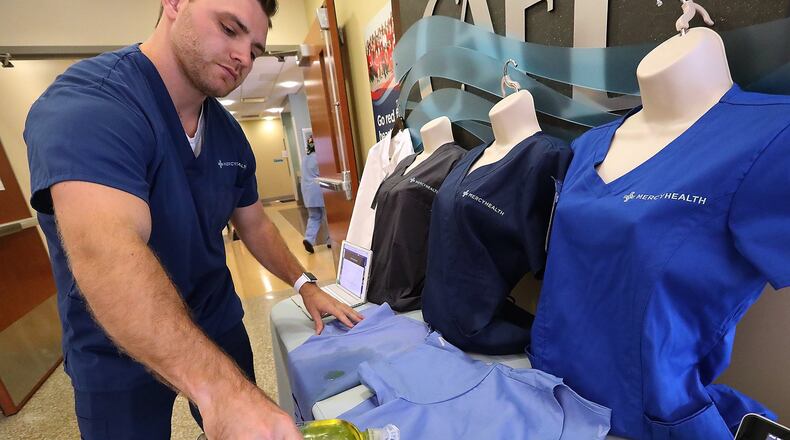MORE: Clark-Shawnee schools won't oppose new housing development
“We’re working to create a core culture that’s very agile and that’s able to embrace change at a rapid pace,” McGoldrick said.
Rich Statuto, who served as president and CEO of Bon Secours, had already taken that company on a similar path before the merger, McGoldtrick said.
Mercy’s interest in investment primarily focuses on companies in the industry that can provide solutions that could potentially be rolled out throughout Mercy’s healthcare system, McGoldrick said. The scrubs made available to employees earlier this year were designed to protect workers from exposure to bodily fluids like blood and urine. Material woven into the fabric of the uniforms is designed to make fluids bead up and roll off the clothing instead of absorbing the liquid.
In most cases where Mercy considered a potential investment, the idea is to look for products or solutions that can be used to improve either the workplace or patient health, McGoldrick said.
MORE BUSINESS NEWS: Speedway to add 300 new jobs in Enon
“If there’s a startup company or a company in general that has a potential solution and is looking for funding, then we’ll engage in those discussions,” he said.
It’s not uncommon for large health care entities to look for more potential streams of revenue, said Thomas Campanella, director of the Health Care MBA and a professor of health economics at Baldwin Wallace University. Some health care entities also develop for-profit subsidiaries that spin off to develop products like medical devices, for example.
“They’re trying to capitalize on the intellectual capital their organization has,” Campanella said.
DETAILS: Clark County jobless rate creeps up as more people look for work
Large health care organizations in particular often have high costs associated with infrastructure, personnel and high-end administrators, Campanella said. That has led some companies to look be more creative and look for additional revenue streams for the company.
“You’re starting to see more of that,” Campanella said.
Mercy’s focus on potential investment in new technology comes from several areas, McGoldrick said. Mercy has joined the Avia Innovation Network along with more than 40 other health care systems, for example. The network is a Chicago-based health company that connects healthcare systems and technology companies.
RELATED: Wittenberg prof says foreign trade pays off for most U.S. workers
“They are basically a clearing house for solutions that are out there for us,” McGoldrick said.
Mercy is also a member of the Innovation Institute, an independent, for-profit LLC that is a collaborative of several nonprofit health system “Member Owners,” including Bon Secours. Based in California with offices in the MidWest and East Coast, it works with its members to develop new ideas and products for the health care industry. Mercy has also developed an internal innovation lab allowing employees and staff to submit ideas to improve hospital processes and suggest medical products that can be evaluated for commercialization.
Mercy also directly invests in other firms in some cases. McGoldrick pointed to a recent investment in NucleusHealth, a San Diego firm that allows medical images to be stored in the cloud and allows radiologists to more easily review medical images.
READ MORE: Honda engineers use algae to capture emissions in spare time
NucleusHealth will still operate as an independent company, but will work closely with Mercy to develop new features and procedures to use its technology. McGoldrick said Mercy’s investments in new medical technology started in 2016 but really stated becoming more serious last year. He declined to discuss the company’s total investments but said “It’s not an insignificant amount of money. I’m pleased to see that growing.”
A work group made up of several departments including finance, business development, nursing and other executives reviews each potential investment to determine if it fits with the company’s priorities, he said. The key is whether the product or service can be used to solve a problem or make care more efficient, he said.
“If we’re not going to operationally deploy it, we’re not looking at it as an innovation investment,” McGoldrick said.
About the Author
